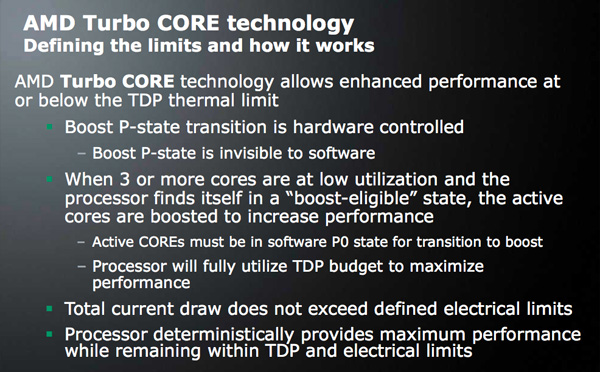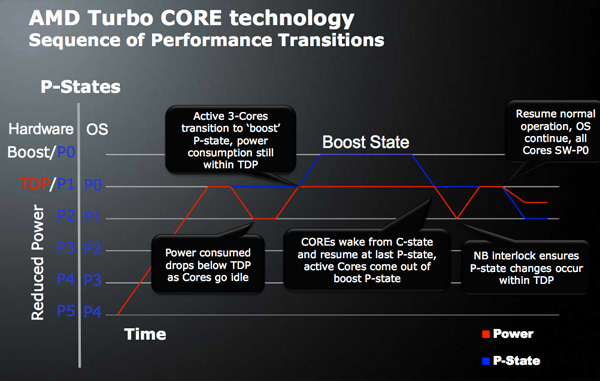AMD Divulges Phenom II X6 Secrets, Turbo Core Enabled
by Anand Lal Shimpi on April 8, 2010 12:00 AM ESTLast month Intel introduced its first desktop 6-core CPU, the 32nm Gulftown Core i7 980X. Running at 3.33GHz we loved the fact that it’s quite possibly the first Extreme Edition part that is able to justify its price. For $999 you get six cores and better performance all in the same power envelope as the current high end quad-core i7s.
The 980X is a great chip, but spending $999 on a single component in your PC is a tough sell for most folks. Luckily, AMD is coming out with its own 6-core processors codenamed Thuban. Below is what we know so far about AMD's Thuban lineup (note, the information in the table was not provided by AMD):
| AMD 2010 Roadmap | |||||||
| CPU | Clock Speed | Max Turbo (<= 3 cores) | L3 Cache | TDP | Release | ||
| AMD Phenom II X6 1090T | 3.2GHz | 3.6GHz | 6MB | 125W | Q2 | ||
| AMD Phenom II X6 1075T | 3.0GHz | 3.5GHz | 6MB | 125W | Q3 | ||
| AMD Phenom II X6 1055T | 2.8GHz | 3.3GHz | 6MB | 125W/95W | Q2 | ||
| AMD Phenom II X6 1035T | 2.6GHz | 3.1GHz | 6MB | 95W | Q2 | ||
| AMD Phenom II X4 960T | 3.0GHz | 3.4GHz | 6MB | 95W | Q2 | ||
Officially branded the Phenom II X6, AMD won’t be launching these processors until some time in the future. But today AMD is disclosing some basic details about the parts. We’re also mixing in our knowledge of internal AMD roadmaps to paint a clear picture of AMD’s 6-core strategy.
The more cores at the same TDP feature that Intel delivers with the 980X, AMD is also promising with Phenom II X6. The difference is that these are still 45nm parts. While we’ll have to test them to be sure, AMD currently indicates that the entire Phenom II X6 lineup will be rated at 95W or 125W TDPs. It’s all manufacturing tricks that make it possible (good job GlobalFoundries). In theory you should be able to buy a Phenom II X6 and have it operate in the same power envelope as a Phenom II X4 965.

With the Thuban cores AMD is introducing its version of Intel’s Turbo Boost technology called Turbo Core. AMD has yet to implement power gating on its processors, so Turbo Core works a little differently than Intel’s Turbo.
Turbo Core kicks in when 3 or more cores (on a 6-core part) are idle. When this happens, the frequency of those three cores is reduced to 800MHz, the voltage to the entire chip is increased, and the remaining three cores are turboed up by as much as 500MHz. It doesn’t get any more granular than this. If you have 3 or more cores idle, then the remaining turbo up. In any other situation the CPU runs at its normal clocks.

The CPU handles all monitoring and does the clock/voltage management itself. The switch to turbo up cores apparently happens fast enough to deal with Windows moving threads around from core to core.

Turbo core is triggered by a deterministic system that is based on load demand and current operating conditions (not temperature).
Cool’n’Quiet is active throughout the turbo process. What actually happens is that when CnQ looks to see if a set of cores should be downclocked, it also has the ability to increase the frequency of other cores.

This isn’t nearly as elegant of a solution as Intel’s turbo. The idle cores are never actually shut off, and voltage to all cores is increased to reach the higher clock speed. However if it works as advertised with no drawbacks (e.g. underclocking 3 cores when you actually still need them) then it’s definitely better than nothing for the Phenom II lineup. AMD will also have quad-core CPUs with turbo core support based on the new Thuban cores.
The great news? All Socket-AM3 and AM2+ motherboards will work with these new Phenom II X6 CPUs with nothing more than a BIOS update. The boards do have to support the TDPs the chips are rated for of course.
Pricing and performance are both unknowns at this point. We’ll keep you posted!










58 Comments
View All Comments
gruffi - Thursday, April 8, 2010 - link
"This isn’t nearly as elegant of a solution as Intel’s turbo."What a funny joke. What AMD does is more clever, more effective and less complex. And that means it IS more elegant.
133 or 266 MHz more for an i7 920. That's impressing. And who the hell had the idea to overclock when all cores are under load? Yes, Intel's turbo is a joke.
silverblue - Thursday, April 8, 2010 - link
If you really want to judge Intel's Turbo Boost, do so with the Lynnfield implementation.gruffi - Saturday, April 10, 2010 - link
Say that to people who purchased a Bloomfield system. Even Lynnfield's implementation is not good, just better than Bloomfield's.fitten - Thursday, April 8, 2010 - link
You have to be completely blinded by fanboi religion to think AMD's solution is "more elegant".MySchizoBuddy - Thursday, April 8, 2010 - link
can the intel fanboy care to explain how one is better than the other.fitten - Thursday, April 8, 2010 - link
I'm guessing you aren't talking to me, seeing as how I own more AMD based machines than Intel ones.Samus - Saturday, April 10, 2010 - link
Where have I heard that line before? Geez.Jaybus - Thursday, April 8, 2010 - link
Hard to say which is better. Current OS schedulers are designed for symmetric processor cores. Threads with a higher priority are more likely to get assigned to a core, but there is no way to tell the scheduler to assign certain threads to the faster cores. A thread's core affinity can be set, but there is no way to know if the core it is set to will be one of the fast ones. So AMD's approach is less useful than it could be for the time being. However, schedulers that can handle asymmetric cores are coming, since they will certainly be needed for scheduling GPU cores that may be on different video cards or integrated on the CPU silicon and will differ in performance. Only benchmarking will tell if one boost method is better. Most likely, one will be better on one OS and one on another OS because of differences in the schedulers.hyc - Thursday, April 8, 2010 - link
You're missing the point. The OS doesn't need to care which core it should assign to; the core will boost automatically if it's needed and there are sufficient idle cores.nichow03 - Friday, April 9, 2010 - link
Actually he has a very good point. With the AMD approach there may be times when it is more efficient for the scheduler to only schedule on 3 cores instead of 6 to initiate turbo.Image a theoretical app/game that uses three cores but no more. The scheduler could run a low priority thread (say the zero page thread in Windows) on the forth core, preventing turbo mode and slowing down the app/game you care about.